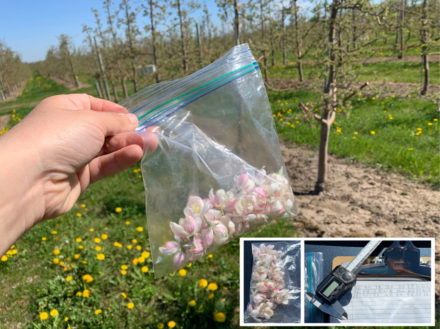NNYADP Apple Research: Computer Modeling Drives Precision Bloom Thinning

Plattsburgh/Peru, N.Y. This spring, New York apple growers are applying the results of a computer modeling-based orchard management research funded by the Northern New York Agricultural Development Program (NNYADP) to more precisely manage their orchard thinning practices with a goal of producing higher quality fruit for harvest this fall. A free recorded webinar highlighting this work is available at www.nnyagdev.org/index.php/nny-farm-videos.
In 2018, with small grant funding from the farmer-driven NNYADP, Cornell University and Cooperative Extension fruit specialists began evaluating how to best time the application of apple bloom thinning materials through use of the Network of Environment and Weather Applications (NEWA) computer modeling system at Cornell University. In 2020, a computer application known as the Pollen Tube Growth Model is available to apple growers for the second year. The model considers input by individual growers to generate orchard application-timing graphs.
The webinar includes a presentation by Cornell University Assistant Professor of Horticulture Gregory Peck, Ph.D., on how growers can implement the model in their own orchards by measuring apple blossom styles at early bloom and determining when enough bloom is open to start the model. NEWA Director Dan Olmstead offers a tutorial on how to enter orchard block, apple variety, and other grower-specific information into the model at https://ptgm.newa.cornell.edu.
Virginia Tech developed the Pollen Tube Growth Model and conducted validation testing in orchards in Virginia, Washington, and New York State. The model can currently be applied to seven varieties of apples: Fuji, Gala, Golden Delicious, Granny Smith, Honeycrisp, Pink Lady, and Red Delicious. For growers in NY, the model uses weather data provided through the Northeast Regional Climate Center at Cornell University.
“Precision thinning early in the current growing season is critical to reducing crop load which encourages return bloom the following season in biennial varieties, including Honeycrisp and Fuji. It also allows us to begin the thinning process early i difficult-to-thin varieties, for example: Gala,” said Michael Basedow, a tree fruit specialist with the Cornell Cooperative Extension Eastern New York Commercial Horticulture Program.
More than 80 growers and educators participated in the live webinar in late March. For more information, contact Michael Basedow at mrb254@cornell.edu, 518-410-6823.
Funding for the Northern New York Agricultural Development Program is supported by the New York State Legislature and administered by the New York State Department of Agriculture and Markets. Learn more at www.nnyagdev.org.
Posted: June 5th, 2020 under Agricultural News, Business News, Environmental News, General News, Peru News, Peru/Regional History.
